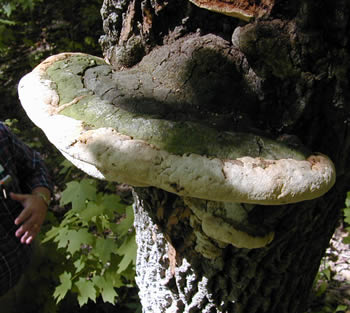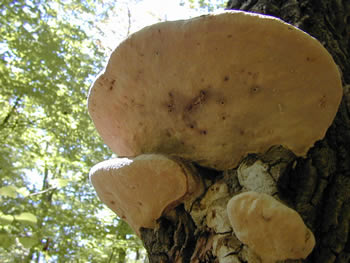Perenniporia fraxinophila
Scientific name: Perenniporia fraxinophila (Peck)
Ryvarden
Derivation of name: Perenniporia means "a polypore with
perennial fruiting bodies"; fraxinophila means "ash loving" in
reference to its most common host, ashes (Fraxinus).
Synonymy: Polyporus fraxinophilus Pk.; Fomes
fraxinophilus (Peck) Sacc.
Common names: Unknown.
Phylum: Basidiomycota
Order: Polyporales
Family: Polyporaceae
Occurrence on wood substrate: Parasitic; solitary or in
overlapping clusters on the trunks of living deciduous trees,
especially ash (Fraxinus); year-round.
Dimensions: Caps up to 9 cm wide; 7 cm long, 7 cm thick.
Upper surface: Grayish-black; glabrous; cracked;
concentrically furrowed.
Pore surface: Ivory to buff; pores 3-5 per mm.
Comments: This perennial species is the major cause of trunk
rot in living ash trees: it "loves them to death." Despite
its
commonness on ash trees, it is not common in field guides.
Another species, P. fraxinea, also parasitizes ash trees but
forms its fruit bodies at the base of living trees unlike P.
fraxinophila which forms fruit bodies high up on the trunk
and main
branches.
More information at MushroomExpert.com

Figure 1. Note the cracked, blackish older portion of
Perenniporia fraxinophila on this ash tree.
Photo © Tom Volk.

Figure 2. Pore surface of
Perenniporia fraxinophila.
Photo © Tom Volk.